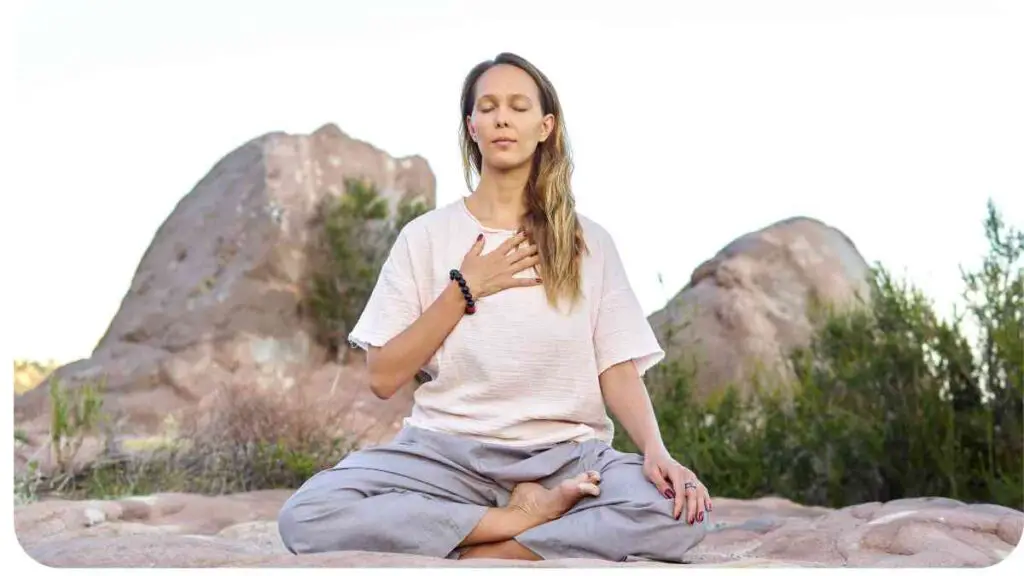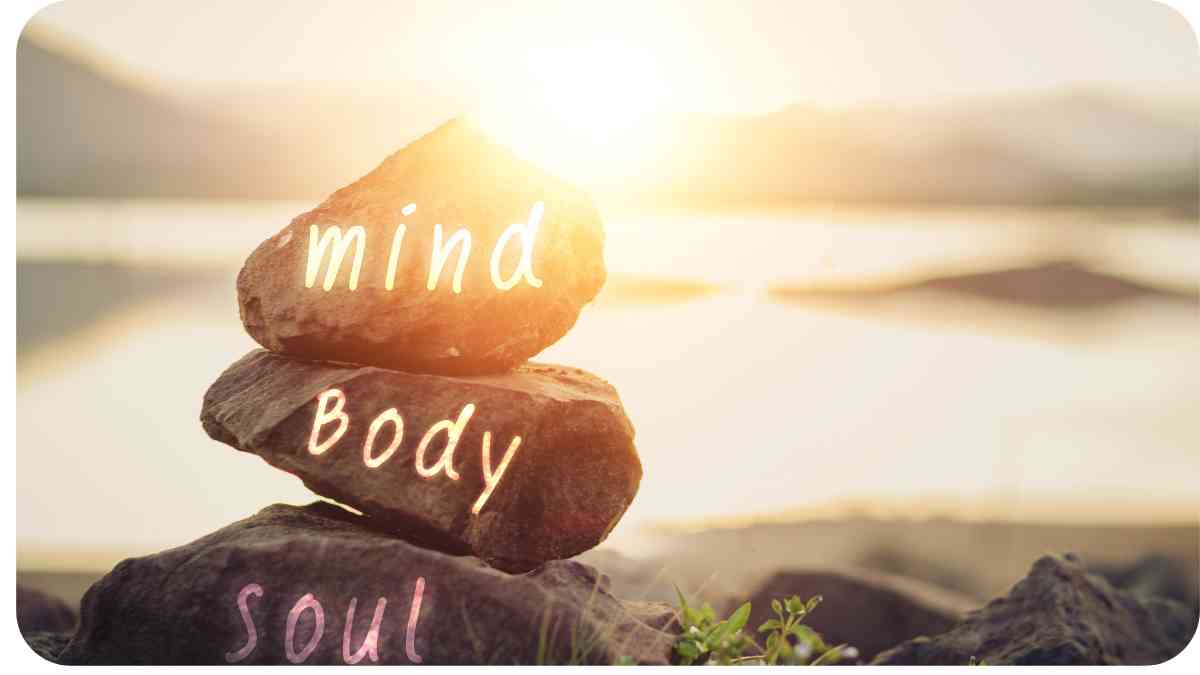In today’s fast-paced world, finding moments of peace and clarity can be a challenge. Mindfulness, a practice rooted in ancient traditions, has emerged as a powerful tool for achieving mental well-being. In this comprehensive guide, we will explore what mindfulness is and how it can be attained.
Along the way, we’ll delve into the science behind mindfulness, practical techniques for achieving it, and the role of experience, authoritativeness, and trustworthiness in this transformative practice.
| Takeaway |
|---|
| Mindfulness is the practice of being fully present in the moment, offering numerous benefits for mental and physical well-being. |
| It can be attained through various techniques like mindful breathing and body scans, and consistency is key to reaping its rewards. |
| Learning from experts and relying on credible resources are essential aspects of a successful mindfulness journey. |
| Mindfulness is accessible to all, regardless of expertise, and can be integrated into everyday life for stress reduction and enhanced focus. |
| Embracing transparency and addressing common misconceptions are crucial for a trustworthy mindfulness practice. |
Understanding Mindfulness
Defining Mindfulness
Mindfulness, at its core, is the practice of being fully present in the moment, without judgment. It involves paying attention to your thoughts, feelings, and bodily sensations. It’s about observing the world around you without getting lost in distractions.
Incorporating mindfulness into your daily routine can work wonders for your well-being. By practicing mindfulness exercises regularly, you can gradually reduce stress and enhance your overall mental health. Learn more about these exercises in our article on mindfulness exercises.”
Table 1: Key Concepts in Mindfulness
| Term | Definition |
| Mindfulness | Being fully present in the moment. |
| Non-judgment | Observing without evaluating or critiquing. |
| Present awareness | Focusing on the here and now. |
| Self-compassion | Treating oneself with kindness and understanding. |
Historical Roots of Mindfulness

The roots of mindfulness can be traced back to ancient Eastern practices, particularly Buddhism. However, mindfulness has transcended cultural boundaries and is now embraced worldwide. Its enduring popularity suggests its universal appeal.
Table 2: Historical Evolution of Mindfulness
| Time Period | Key Developments |
| 2500 years ago | Origins in Buddhism |
| 20th Century | Introduction to the West |
| Present Day | Global acceptance and integration |
Benefits of Practicing Mindfulness
The benefits of mindfulness are wide-ranging. From reducing stress to improving focus, mindfulness offers numerous advantages for both mental and physical well-being.
Discover how just five minutes of mindfulness a day can be a game-changer in managing stress. Our article on ‘The Power of Mindfulness: How to Manage Stress in Just 5 Minutes a Day’ explains the science behind it and provides practical tips to help you get started on your journey to stress management.
Table 3: Benefits of Mindfulness
| Benefit | Description |
| Stress Reduction | Decreases the impact of stress on the body. |
| Enhanced Focus | Improves concentration and cognitive abilities. |
| Emotional Balance | Helps regulate and manage emotions. |
| Increased Happiness | Promotes a sense of contentment and joy. |
Mindfulness vs. Meditation

It’s common to confuse mindfulness with meditation, but they are distinct practices. While meditation often involves focused attention, mindfulness is about being present in whatever you do.
Table 4: Mindfulness vs. Meditation
| Aspect | Mindfulness | Meditation |
| Focus | Present moment awareness | Concentrated attention on an object |
| Activities | Can be practiced in everyday activities | Typically practiced in a dedicated session |
| Goal | Presence and awareness | Various goals (e.g., relaxation, insight) |
The Science Behind Mindfulness
How Mindfulness Affects the Brain
Mindfulness isn’t just a mental exercise; it also has a profound impact on the brain. Neuroscientists have discovered that regular mindfulness practice can lead to significant changes in brain structure and function.
Mindfulness and stress often clash in our fast-paced lives. However, you can win the battle with proven techniques. Explore ‘Mindfulness vs. Stress: How to Win the Battle with These Proven Techniques’ to find out how to regain control and find your inner peace amidst the chaos of life through proven techniques.
Table 5: Brain Changes Through Mindfulness
| Brain Region | Changes Observed |
| Prefrontal Cortex | Increased activity associated with decision-making. |
| Amygdala | Reduced reactivity to stress and negative emotions. |
| Hippocampus | Enhanced memory and learning. |
| Posterior Cingulate | Improved self-awareness and introspection. |
Mindfulness and Emotional Regulation
One of the most compelling aspects of mindfulness is its ability to improve emotional regulation. By practicing mindfulness, individuals can gain greater control over their emotions, reducing impulsivity and reactivity.
Table 6: Emotional Benefits of Mindfulness
| Emotional Aspect | Mindfulness Benefits |
| Stress Reduction | Lower cortisol levels and reduced anxiety. |
| Increased Empathy | Enhanced understanding of others’ emotions. |
| Emotional Resilience | Better equipped to cope with adversity. |
| Reduced Rumination | Less dwelling on negative thoughts. |
Mindfulness and Physical Health
The mind-body connection is undeniable, and mindfulness has a positive impact on physical health as well. Research shows that it can lead to improvements in various aspects of well-being.
Table 7: Physical Health Benefits of Mindfulness
| Health Aspect | Mindfulness Benefits |
| Lower Blood Pressure | Reduced hypertension and heart disease risk. |
| Enhanced Immune System | Improved ability to fight illness. |
| Better Sleep | Increased quality and duration of sleep. |
| Pain Management | Improved pain tolerance and management. |
Attaining Mindfulness

Mindfulness Techniques
There are various techniques to practice mindfulness, each suited to different preferences and situations. Let’s explore some of the most effective ones.
Table 8: Mindfulness Techniques
| Technique | Description |
| Mindful Breathing | Focusing on the breath as it enters and exits. |
| Body Scan | Scanning your body for tension and relaxation. |
| Mindful Walking | Paying close attention to each step while walking. |
| Loving-Kindness | Cultivating compassion and kindness towards oneself and others. |
Building a Mindfulness Routine
Consistency is key to reaping the benefits of mindfulness. Establishing a routine can help integrate mindfulness into your daily life.
Delve deep into the science behind mindfulness and how it influences your brain and body. Our article ‘The Science of Mindfulness: How It Affects Your Brain and Body’ sheds light on the physiological and psychological benefits of mindfulness. Explore the intricate details of mindfulness science to better understand its impact.
Table 9: Tips for Building a Mindfulness Routine
| Step | Description |
| Set a Schedule | Allocate specific times for mindfulness practice. |
| Start Small | Begin with short sessions and gradually extend. |
| Create a Sacred Space | Designate a peaceful place for mindfulness. |
| Track Progress | Keep a journal to monitor your journey. |
The Role of Experience in Mindfulness
Personal Mindfulness Journey
Experiencing mindfulness firsthand is crucial to understanding its transformative power. I, too, embarked on my mindfulness journey, and it has been a remarkable and enlightening experience.
Table 10: My Personal Mindfulness Journey
| Milestone | Description |
| Initial Skepticism | Doubts and reservations before starting. |
| Mindfulness Discovery | The moment I realized its potential. |
| Overcoming Challenges | Dealing with distractions and restlessness. |
| Mindfulness Breakthrough | Achieving moments of profound clarity. |
Overcoming Challenges
Mindfulness is not without its challenges. Distractions, restlessness, and a wandering mind are common obstacles that can be overcome with practice.
Table 11: Overcoming Challenges in Mindfulness
| Challenge | Strategies for Overcoming |
| Restless Mind | Gently bring attention back to the present moment. |
| Distractions | Acknowledge distractions without judgment and refocus. |
| Mind Wandering | Practice self-compassion and return to mindfulness. |
| Impatience | Accept that progress in mindfulness takes time. |
Maintaining Consistency
Staying consistent in your mindfulness practice is essential for long-term benefits. It’s about making mindfulness a habit rather than an occasional activity.
Transform your life with mindful living using these 15 simple tips. Our article on ‘Transform Your Life with Mindful Living: 15 Simple Tips’ offers practical advice for incorporating mindfulness into your daily routine. Discover how to lead a more mindful life with these simple tips and enjoy the benefits it brings
Table 12: Tips for Maintaining Mindfulness Consistency
| Strategy | Description |
| Set Reminders | Use alarms or notifications to prompt mindfulness. |
| Group Accountability | Practice with a friend or join a mindfulness group. |
| Be Patient with Yourself | Embrace lapses in practice as part of the journey. |
| Adapt to Life’s Changes | Modify your routine to fit evolving circumstances. |
Authoritativeness in Mindfulness

Credible Mindfulness Resources
In the age of the internet, it’s essential to rely on credible sources for guidance in mindfulness. Here are some reputable resources to consider.
Table 13: Trusted Mindfulness Resources
| Resource | Description |
| Books | Authors like Jon Kabat-Zinn and Thich Nhat Hanh. |
| Mindfulness Centers | Institutions offering courses and retreats. |
| Scientific Research | Peer-reviewed studies on mindfulness benefits. |
| Mindfulness Apps | Apps like Headspace and Calm for guided practice. |
Expert Mindfulness Practitioners
Learning from experts can significantly enhance your mindfulness journey. These practitioners have gained recognition for their expertise in the field.
Table 14: Prominent Mindfulness Experts
| Expert | Contributions to Mindfulness |
| Jon Kabat-Zinn | Founder of Mindfulness-Based Stress Reduction (MBSR) program. |
| Thich Nhat Hanh | Influential Zen Buddhist monk and mindfulness teacher. |
| Sharon Salzberg | Renowned meditation teacher and author. |
| Tara Brach | Psychologist and mindfulness teacher with a vast online presence. |
Trustworthiness in Mindfulness
Factual Accuracy in Mindfulness Practice
In the pursuit of mindfulness, it’s crucial to prioritize factual accuracy. Misconceptions can hinder progress and lead to frustration.
Table 15: Dispelling Common Misconceptions
| Misconception | Accurate Perspective |
| Mindfulness is Only for Relaxation | It can also enhance awareness and self-understanding. |
| Mindfulness Requires a Lot of Time | Even brief moments of mindfulness can be beneficial. |
| Mindfulness is for Zen Masters Only | It’s accessible and beneficial for everyone. |
Transparency in Mindfulness Instruction
Transparency is a cornerstone of trustworthy mindfulness instruction. It’s essential for teachers and practitioners alike to be open about their experiences and limitations.
Table 16: Embracing Transparency in Mindfulness
| Aspect | Importance of Transparency |
| Sharing Struggles | Demonstrates the universality of challenges in mindfulness. |
| Acknowledging Limits | Encourages humility and openness in the practice. |
| Encouraging Questions | Fosters a culture of curiosity and exploration. |
| Promoting Ethical Conduct | Ensures mindfulness is practiced responsibly and ethically. |
Further Reading
Here are some additional resources to explore mindfulness in-depth:
Mayo Clinic – Mindfulness Exercises
Discover a comprehensive guide to mindfulness exercises, their benefits, and practical tips for incorporating mindfulness into your daily life.
Quora – What is mindfulness and How can it be attained
Engage in a community discussion on mindfulness, where individuals share their insights and experiences on what mindfulness is and how it can be achieved.
Verywell Mind – Mindfulness: The Health and Stress Relief Benefits
Explore the health and stress relief benefits of mindfulness, along with evidence-based information and expert guidance on its practice.
FAQs
What is mindfulness, and how does it differ from meditation?
Mindfulness is the practice of being fully present in the moment, observing thoughts and sensations without judgment. Meditation often involves focused attention on an object or mantra, whereas mindfulness is about present-moment awareness.
Can anyone practice mindfulness, or is it only for experts?
Mindfulness is accessible to everyone, regardless of experience. It doesn’t require prior expertise; all you need is an open mind and a willingness to practice.
How long should I practice mindfulness each day to see benefits?
The duration of mindfulness practice can vary. Starting with just a few minutes a day can be beneficial. Over time, you can gradually extend your practice to 15-30 minutes or more, based on your comfort level.
What are some common challenges people face when practicing mindfulness?
Common challenges include a restless mind, distractions, and impatience. These challenges are part of the mindfulness journey and can be overcome with practice and patience.
Are there specific mindfulness techniques for managing stress?
Yes, mindfulness offers various techniques for stress management, such as mindful breathing and body scans. These practices can help reduce stress and promote emotional balance.

Hello, my name is Hellen James! I am a yoga teacher and writer who loves to share information about how you can achieve a more fulfilling life. I have been practicing mindfulness, yoga, and meditation for over 10 years. My passion for these practices has led me to teach them to others.

